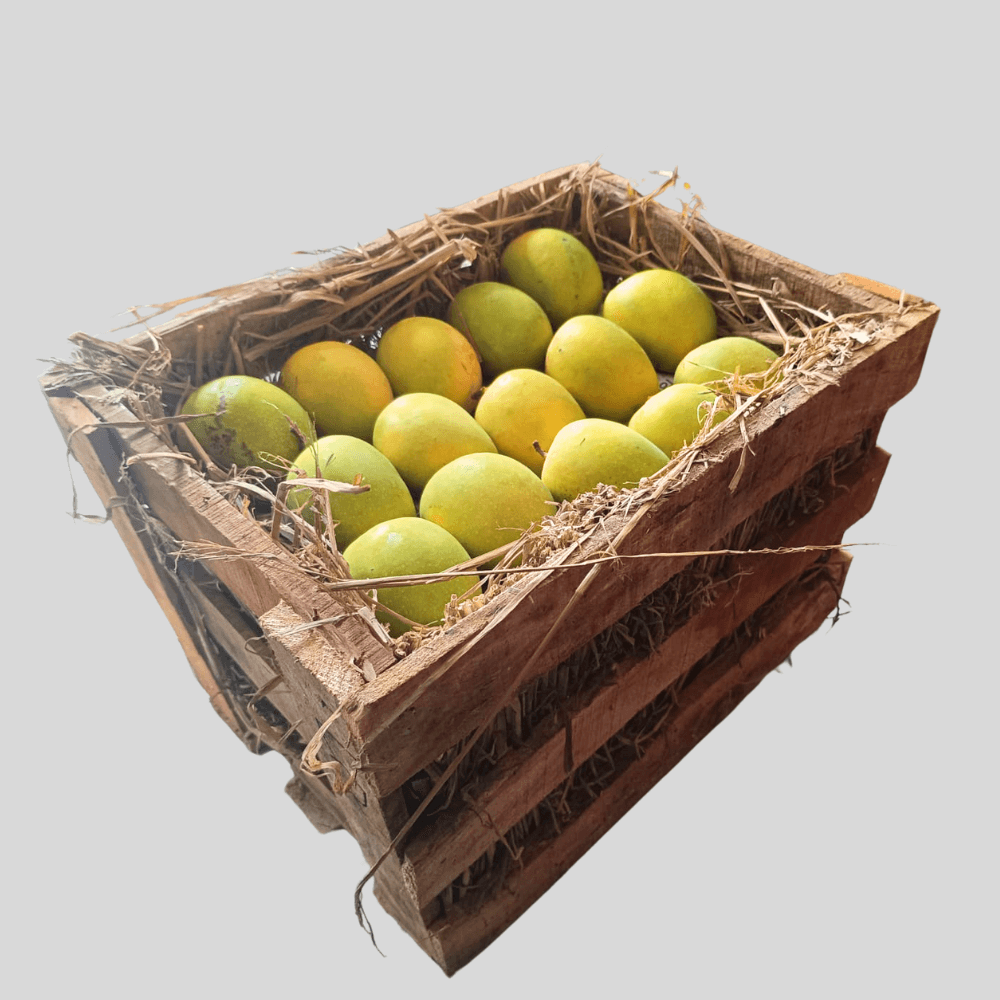₹2,099 – ₹4,199Price range: ₹2,099 through ₹4,199
Out of stock
In 1 dozen packages, there are 12 mangoes, each weighing approximately 250-280 grams kept in rice straw with sleeves and butter paper.

Hapus Ratnagiri is another name for Ratnagiri Alphonso mangoes. Mangoes from the Coastal area of Ratnagiri with a Brilliant yellow color and red hint, nonfibrous juicy pulp. Charming organic product. Loved the sensitive taste, very little fiber, and delicate Fragrant Brilliant saffron-tinted variety of tissue and surface known as the King of Fruits. However, the yield king has all around viewed as the Alphonso natural products, particularly while thinking about this and exactly the Ratnagiri Jumbo Alphonso Mango assortment from Maharashtra.
With an ideal blend of sweet-smelling sharpness and pleasant flavor. It has a brilliant golden-yellow saffron tint with a velvety, gently smooth surface.
Specifications of the Product
In 1 dozen packages, there are 12 mangoes, each weighing approximately 250-280 grams kept in rice straw with sleeves and butter paper.
Why should you buy from Ratnagiri Hapus?
We are Ratnagiri Hapus Alphonso Mango Online Store. We give the best quality Hapus from Ratnagiri Region and from different Talukas of Ratnagiri with Famous Devgad Hapus (Alphonso Mango) from the Locale of Sindhadurga. Alphonso Mango originated in Ratnagiri and can be effectively accessible in Pune and Mumbai. We Give Fresh and Chosen Ratnagiri Large Alphonso Mangos from notable farmers who have a legacy of mango development for a long time
Benefits of Alphonso Mangoes
As the source of iron, mango can able to prevent anemia. Anemia is the stage when how much red blood in our body is low. To expand the development of red blood, particularly for ladies, the body needs iron which is normally contained in fish, vegetables, and natural products including alphonso mango.
Find out more about Alphonso Mangoes by reading this blog.
| Weight | 3.2 kg |
|---|---|
| Dimensions | 38 × 28 × 12 cm |
| Pack in Dozen | 1 Dozen, 2 Dozen |

• Mangos are the most popular fruit in the world.
• Mangos were first grown in India over 5000 years ago.
• Mango seeds traveled with humans from Asia to the Middle East, East Africa and South America beginning around 300 or 400 A.D.
• The paisley pattern, developed in India, is based on the shape of a mango.
• The mango is a symbol of love in India, and a basket of mangos is considered a gesture of friendship.
• Legend says that Buddha meditated under the cool shade of a mango tree.
• Mangos are related to cashews and pistachios.
• A mango tree can grow as tall as 100 feet.
• The bark, leaves, skin and pit of the mango have been used in folk remedies for centuries.
Read More Infomation Relation Related To Magoes On Ratnagirihapus.Store/Ratnagiri-Hapus-Blog/
General: Raw Mangos Are Plucked From The Mango Tree Before The Same Day Before The Delivery And Packed Into The Wooden Box With Rice Straw.
Note: Don’t Keep It In Refrigerator Or In Direct Sunlight, And Don’t Break The Branch Of The Mango.
Step 1: Fruits Ripen Gradually In 6 To 8 Days. However, As A Best Practice, Always Keep A Watch On Them.
Step 2: For The First 4 Days Keep The Mangos In The Wooden Box At The Room Temperature As It Is. Note: Don’t Keep Them In Direct Sunlight.
Step 3: On The 5th Day Check The Color Of The Mango It Should Be Yellow At The Top. Caution: Don’t Let Mangos Branch To Break Or The Mango Will Get Black Spots.
Step 4: Lay Some Rice Straws On The Floor And Keep Any Paper (Newspaper) On It.
Step 5: You Have To Keep The Mangos In Sequence On The Laid Paper With Rice Grass.
Step 6: Keep The Paper On It, And Lay A Cloth On It And Keep Watch Over Them.
Step 7: In 2 To 3 Days They Will Ripen And They Will Smell Delicious So You Can Eat Them Now.
Read More Infomation Relation Related To Magoes On Ratnagirihapus.Store/Ratnagiri-Hapus-Blog/
General: Raw Mangos Are Plucked From The Mango Tree Before The Same Day Before The Delivery And Packed Into The Wooden Box With Rice Straw.
Note: Don’t Keep It In Refrigerator Or In Direct Sunlight, And Don’t Break The Branch Of The Mango.
Step 1: Lay some rice straws on the floor and keep any paper (newspaper) on it.
Step 2: You have to keep the mangos in sequence on the laid paper with rice grass.
Step 3: Keep the paper on it, and lay a cloth on it and keep watch over them.
Step 4: In 2 to 3 days they will ripen and they will smell delicious so you can eat them now.
Read more infomation relation related to Magoes on ratnagirihapus.store/ratnagiri-hapus-blog/
Transportation & Delivery Process
As Mangoes comes under Perishable food which have a limited shelf life after harvest or production. The delay before they become unmarketable or inedible depends on the food product itself and a number of environmental factors and transportation.
It take Around 3-7 days to delivery mangoes to your home.